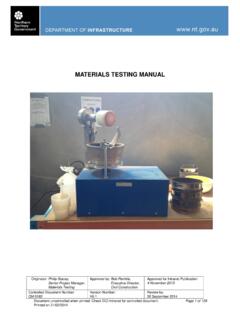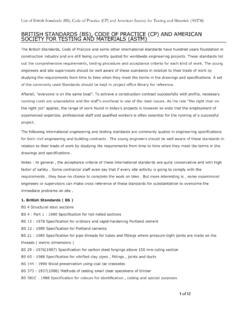Transcription of SPECIFICATION WRITING GUIDANCE - dipl.nt.gov.au
1 Doc ID Version Issued Printed Page SpecGuideBooklet Sept 2016 19/09/2016 1 of 2 SPECIFICATION WRITING GUIDANCE Interpret each rule as if followed by unless context and common sense dictate otherwise. Do not follow a rule if clarity is reduced. This is the #1 RULE. From document #3. The excerpts following these introductory pages are presented as general GUIDANCE for WRITING Specifications. The source documents numbered 1 to 4 are from foreign jurisdictions but the grammatical principles are universally applicable. Be aware of the jurisdictional specific content it most likely does not apply to NTG Requests for Tender (RFT). The source documents, and aspects in each to note, are; 1. guide to WRITING Specifications, Masterspec, New Zealand This is a comprehensive guide . The content is appropriate to Australia and NTG in most aspects because New Zealand uses a system similar to Australia s NATSPEC, and because of the cultural similarities between the two nations.
2 The Classification and Coding section on pages 8 and 9 are slightly different to NATSPEC. 2. SPECIFICATION and WRITING Style Manual, Oregon Department of Transportation, USA The USA documents use Imperial measurements, we use Metric. On page 7 the document suggests avoiding use of the word shall but then uses it in table in a subsequent paragraph as an appropriate term. Do not use shall in NTG RFTs. 3. SPECIFICATION Style guide , California Department of Transportation, USA Minor jurisdictional differences. 4. A guide to WRITING Specifications, Los Angeles Unified School District, USA Minor jurisdictional differences. Do not use shall in NTG RFTs. 5. WRITING Better Technical Specifications, G Covey & G Faber, Somerset, Tasmania This document is written as GUIDANCE for engineers who are specifying works related to plant and equipment. The document offers valuable general GUIDANCE . Doc ID Version Issued Printed Page SpecGuideBooklet Sept 2016 19/09/2016 2 of 2 The two documents cited below contain simple checklists which are reproduced here.
3 Developing Specifications for Purchasing, Queensland Government Step 3: WRITING the SPECIFICATION Some WRITING Use simple, clear language without jargon (to minimise misinterpretation). Define terms, symbols and acronyms (include a Glossary of Terms ). Be concise. Do not explain the same requirement in more than one section. Define each aspect of the requirement in one or two paragraphs where possible. Adopt a user-friendly format. Number the sections and paragraphs. Seek feedback from someone unfamiliar with the requirement. Discuss the draft and refine it. There are no fixed rules on formats and structures because each SPECIFICATION reflects a different requirement or need. A SPECIFICATION should list the functional, performance and technical characteristics separately. SPECIFICATION WRITING , Victorian Government - August 2010 $File/D09%2056929%20%20 GUIDELINE%20 WEB%20 COPY%20 SPECIFICATION % - Link now defunct Vetting Specifications It is useful to have the SPECIFICATION vetted by someone other than the author.
4 The person vetting the SPECIFICATION should check that the SPECIFICATION : is easy to read; is easy to understand; is clear; is consistent with specifications for similar or the same goods and/or services; has a logical structure; and contains only essential information. NATSPEC also has GUIDANCE documents for SPECIFICATION writers. Some of these are available via the Documentation Services web site. August 2005 guide to WRITING Specifications August 2009 1 Table of Contents WRITING specifications .. 2 Specifying methods .. 5 The SPECIFICATION form .. 6 Classification and coding .. 8 Master SPECIFICATION systems .. 9 Issues affecting specifying .. 12 2 WRITING specifications This guide will help you when WRITING specifications, particularly those based on a standard SPECIFICATION system such as Masterspec. It also explains the approach taken in the Masterspec standard text to grammar and style. This will act as a guide to amending existing and WRITING new, SPECIFICATION clauses.
5 If not defined, or taken from a listed reference document such as a New Zealand standard, words used in Masterspec have the meaning defined by the Concise Oxford Dictionary. WRITING style and punctuation generally follows the New Zealand Style Book (GP Publications 1991). While texts on construction specifications are not common Specifying Architecture by John Gelder (published by NATSPEC, Australia) offers a good grounding in both the history and theory of SPECIFICATION WRITING . WRITING style Style is the cornerstone of readability, ensuring text is relevant and capable of being clearly understood by its intended readership. Style includes a good but not pedantic approach to grammar, simple sentence structure and correct punctuation. Style also means following the sometimes neglected rules of SPECIFICATION WRITING : clarity accuracy repetition brevity logic Clarity means using plain English, avoiding legalese and jargon and restricting vocabulary to words in common usage.
6 Avoid using alternatives (like excavate for dig) just to make the text more interesting. Nevertheless words should be selected to ensure that their meaning is clear and unambiguous, while phrasing should be brief and expressed in the imperative mood. Use Provide light not The contractor shall provide light Accuracy Ensure consistency and accuracy by using the same simple terms throughout ( use, supply, submit ) and employ accurate and consistent phraseology for repeated clauses. Avoid generalisations, or unclear words or phrasing. Avoid acronyms and abbreviations, unless very well known and incapable of simple error. Blanket clauses implying responsibility for the general or the unknown, must be avoided. Don t use gender-specific words and phrases. And avoid nominating specific control functions to particular persons (say architect, engineer, surveyor) unless this is intended. In particular avoid words such as approve or approved unless this is an essential requirement of the contract.
7 Avoid redundant and misleading paragraphs; in particular poorly or loosely worded SCOPE clauses at the start of SPECIFICATION sections. SCOPE clauses are legally dangerous as they could be taken by a contractor or subcontractor as encapsulating everything that is required. They are best avoided altogether. At the most they should be restricted to a simple extension of the section title. Also avoid clauses such as read the General section with this section, which might imply that the SPECIFICATION can be broken up into individual parts a dangerous process contractually. And don t repeat general instructions to the contractor in every section unless there is a particular concern (such as the prevalence for some workers to leave debris on site, or a specific risk of damage to adjoining work or finished work). Avoid listing overly specific, or indefinable requirements such as best trade practice, first class work, or acceptable standard.
8 Only require approval or inspection where this fulfils some specific purpose. Also carefully check secondary consultants and specialists SPECIFICATION sections to ensure consistency of meaning. Some consultants can include indefinite phrases like builders work, or include contractual issues, or even monetary amounts in among the technical data. 3 Repetition Documents are meant to be complimentary. The principles to follow are: x say everything, but say it only once. Repetition is inadvisable and legally dangerous x avoid erroneous information (such as listing a standard that is not referenced in the text) x just in case x if something applies, include it once, If something does not apply, remove it or leave it out x if information is on the drawings , don t repeat it in the SPECIFICATION , unless the subject x requires amplification x if an issue is covered in the conditions of contract, don t repeat it in the SPECIFICATION .
9 Matters of contract and/or tender must not be included within the technical text. Brevity You would not include irrelevant details on drawings and similarly there is no justification for including irrelevant clauses or redundant words in the SPECIFICATION . Logic The Masterspec sections are set in an easily recognisable pattern, with logical and meaningful clause titles and a logical numbering system for all clauses. cross -referencing within the SPECIFICATION is kept to a minimum, because of possible future changes or project-based modifications. Where unavoidable, clause names rather than numbers are used for cross referencing. Keep matters of contract, tender and administration separate from the technical sections of the SPECIFICATION , except for specific instructions on quality, or for instructing/informing others (such as a sub-contractor); for example the obtaining of samples, tests and certification, the setting of standards of performance, requirements to provide guarantees, warranties, as-builts, or maintenance information.
10 This approach allows the technical sections to be more readily used with any chosen method of pricing, administration or contract. It also adds certainty for the contractor and/or project manager when attempting to locate all relevant contract, pricing or administrative requirements. Don t specify for failure, such as specifying repairs following damage. That is for the conditions of contract to resolve. Don t address individual matters to the contractor. The whole document is addressed to that one person or entity. Words and meanings Words whose meanings are unclear, subjective, or even too precise, should be avoided. In the USA design professionals insurers often issue lists of what are known as red flag words. These are words which are best avoided, or words which should only be used with caution and deliberate intent. Such words include: Administer advise all any Approve assure best certify Complete control direct ensure Equal estimate every final Full guarantee inspect maximise Minimise none optimise oversee Periodic safe shall sufficient Suitable supervise will SPECIFICATION WRITING The process of SPECIFICATION WRITING , conducted in parallel with design and drawing work, helps create the proper balance between client, statutory, technical and aesthetic requirements.




